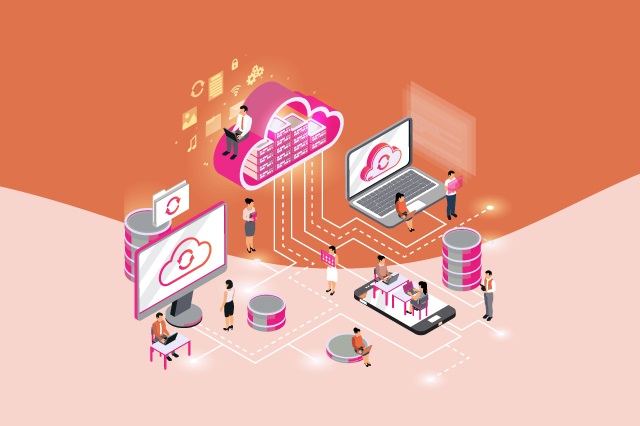
Digital transformation is the use of technology to change the way an organization operates. This includes changing products, services, processes, and strategies. The goal of digital transformation is to improve the organization's ability to compete by better engaging and serving its workforce and customers.
A Digital Workplace provides personalized, role-based services as well as data, applications, & collaboration tools required for employees to work from anywhere, on any device, at any time.
What are Digital transformation technologies?
Technology is both a driver and enabler of digital transformation. It is the force that is pushing organizations to change the way they operate, and it is also the tools and resources that they need to make that change happen. While no single technology can transform an organization on its own, there are a few key technologies that are essential for digitalization.
1. Cloud Computing: which gives an organization quicker access to its software, new functionalities, and updates, along with data storage from anywhere always.
2. Commoditized information technology: which gives an organization the ability to focus investment dollars and people resources on the IT customizations that differentiate it in the marketplace.
3. Mobile Platforms: which allow work to occur wherever and whenever.
4. Machine learning & AI: which, when fuelled by comprehensive data programs, provide organizations with insights for faster, more accurate decisions around sales, marketing, product development and other strategic areas.
5. Automation: such as RPA, which deploys bots that can handle tasks faster and more accurately than humans who are freed from such tasks to pursue higher value work.
Here are some other emerging transformational technologies that can help organizations to move faster, work more efficiently, and create new products and services:
a. Block Chain
b. Social Media
c. IOT
d. Augmented Reality & Virtual Reality
What does Digital Transformation in the office mean?
Digital transformation is the use of technology to improve communication and knowledge sharing within an organization. This can help to improve employee engagement and collaboration, and ultimately lead to better decision-making and performance.
While digital transformation in the office condition looks different from situation to situation, here are various key characteristics.
Increased Collaboration
There are many ways to encourage employee engagement, such as providing clear goals and expectations, giving employees a sense of ownership, and recognizing their contributions. This requires putting together teams with different knowledge bases & positions, engaging in knowledge sharing, building trust, promoting transparency.
Efficient Cloud based systems
Cloud based services are agile & economical. This will allow businesses to decide the services that meet their precise needs. Thus, they can streamline their IT infrastructure costs. The way that systems and office networks are designed and implemented can have a major impact on how work is done in an organization. It allows for better accessibility and monitoring of business processes.
Data – Driven Strategies
Data is a key ingredient in digital transformation in the place of work. A data driven approach allows you to collect and analyse data from different approaches and strategies.
Why is Digital Transformation Important?
Digital transformation aims to leverage technologies to create value for stakeholders. Transformative technologies are changing the way we work, communicate, and collaborate. Most importantly, digital transformation allows business functions such as HR or Finance to move away from traditional/manual processes. Employees can now automate aspects of business. These include things like computerizing payroll so that managers can focus on other chances.
Benefits of Digital Transformation
Digital transformation is the use of technology to change the way an organization operates. This can help organizations to improve their efficiency, effectiveness, and agility, which can lead to higher revenue and bigger profits.
Increased efficiency & effectiveness: as the implementation of technologies such as AI & RPA boost worker productivity, reduce errors and speed time to market.
Improved engagement with customers, employees & business partners: as organizations can better process data to make smarter, more accurate decisions and anticipate the needs of their stakeholders. Essential tools to support Digital Transformation.
Communication Tools: Good communication perquisites for the success of any company, it impacts productivity & success of your employees and organization daily.
CRM Tools:it plays vital role in providing right information & data you need and that integrates with other tools in technology stack. So that you can develop an effective go to-market strategy to meet your customers’ expectations.
Project Management Tools: it is important to not only choose the right digital project management tool for your organization, but also ensure the tool is widely adopted.
The use of recruitment management tools: recruitment, and onboarding can have a lasting impact on an organization's culture, performance, and profitability. With a digital recruitment tool, you can easily identify, and share resumes with team members and hiring managers, that help HR and recruitment teams saves time for qualifying right candidates.
Payroll Management Tools:when transforming a business, you need to include tools to automate various HR processes like payroll & expenses processes. As a result, Payroll management tools automate the tasks of filling in spreadsheets and tables, freeing up HR and employees to focus on more important tasks.
Final thoughts
By treating digital transformation as a cultural change, organizations can help their employees focus on aspects of their work that can be streamlined. Effective leadership is necessary to convince employees of advantage of change. When done right it gently nudges employees to get out of their comfort zone and identify cracks in current processes. Employees can focus on the things they are good at, while organizational leaders handle the things that require more specialized skills.
About Author
Naga Pujitha is Recruiter - Executive at Chimera Technologies. Besides writing, she enjoys singing, dancing, reading novels, drawing, and acting.


